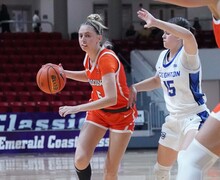Quality and quantity: Honors program grows, grapples with accommodating increased enrollment, graduation rates
Editor’s Note: This series explores how the Renee Crown University Honors Program has changed since its overhaul in 2005, and where those involved wish to see it head.
For years, the Syracuse University honors program held a tradition that allowed every student graduating with honors to speak at the program’s convocation — that’s how few students were enrolling in and graduating from the program.
“You could do that when there were 40 students. When it got to be 80, it was impossible. When it hit 100, nobody would have thought of it as an idea,” said Samuel Gorovitz, founding director of the Renee Crown University Honors Program.
The honors program at SU was revamped in 2004-05 when Gorovitz stepped in as its director. The structure, focus and requirements of the program were rethought and changed to better focus on students’ interests. The program was renamed the Renee Crown University Honors Program in 2002, and has been steadily increasing its enrollment and graduation rates since.
Although the program is graduating more students than ever before, the percentage of students who graduate from it is low compared to other universities. Less than half of the students enrolled in the honors program graduate from it, on average. But those connected to the program say it does not have the facilities or resources needed to enroll or graduate a larger number of students.
Consider the numbers:
- Before SU’s honors program was revamped, it was graduating an average of 64 students every year. Now, the Renee Crown University Honors Program graduates 106 students on average.
- The Renee Crown University Honors Program enrolls about 250 students per grade, or about 7 percent of SU’s undergraduate student body, said Eric Holzwarth, deputy director of the honors program.
- Of the 250 students in any given grade who are enrolled in the program, a little more than 100 students graduate from it. On average, the Renee Crown University Honors Program graduates about 42 percent of students who enroll.
- In comparison, The Honors Program at the University of Connecticut enrolls about 438 students per grade, or 10 percent of the university’s undergraduate students. Each year, the program graduates about 60 percent of them, said Jennifer Lease Butts, the program’s director.
- Pennsylvania State University’s Schreyer Honors College enrolls about 670 students per grade, less than 3 percent of its undergraduates. It graduates about 75 percent of enrolled students, said Dean Christian Brady.
While SU’s numbers are lower than those of other schools, it’s hard to pinpoint why students drop out of the program, said Holzwarth, deputy director.
“If we could predict which 100 of the 250 would succeed, we’d drop our numbers down. But we can’t. There’s not an algorithm for that,” he said.
Some students drop out because they can’t maintain the required 3.4 GPA, Holzwarth said. Others drop out because they have a hard time balancing one or two majors with the program’s requirements.
“Honors offers wonderful opportunities, but it’s also pretty demanding,” he said.
To graduate from the Renee Crown University Honors Program, students must complete 13 honors credits. They must also meet other requirements, such as completing 50 hours of civic engagement, completing a collaborative course and a capstone project.
The capstone project can be any project that relates to a student’s major. Students must submit a proposal their junior year, then submit an update the following semester.
Capstone projects have been wide and varied. In one case, a student went to Africa to study the water quality. One student studied the effect of social media on personal relationships. Another student went to Alaska twice in one year to study Inuit culture.
The goal of the project is to allow students to graduate having completed a project that is of a professional caliber, Holzwarth said.
While some flourish in the process of working on their project, others find it’s too much work. But, Holzwarth stressed, just because a student drops out of the honors program does not mean he or she isn’t smart.
“The kids who finish, when they’re done, are amazingly proud of what they do, and that’s what we focus on,” he said. “And the kids for whom that’s really not the best thing to do, that’s OK.”
Students can enter the Renee Crown University Honors Program through several ways. Some are invited to enroll upon coming to SU as freshmen; others are current students who are invited to join if they meet a certain GPA requirement; and some apply to join the program during their sophomore year or later — though it is much harder, if not impossible, to complete the program if started later than sophomore year.
Hanna Richardson, associate deputy director of the Renee Crown University Honors Program, said this year, current students with a GPA of 3.86 or higher were invited to join. Richardson said a higher number of current students accepted this invitation than ever before.
“Our response rate used to be right around 38 percent for the invitation of current students,” she said. “And this semester, of those who were invited, 53 percent said yes.”
This is another indication of the increasing interest of students in the program, Richardson said.
And while that increasing interest is good for the program — a program that was once graduating only 64 students a year — Director Stephen Kuusisto said staff must now find ways to accommodate the increasing influx of students.
The honors program is located on the third floor of Bowne Hall. It’s made up of several offices, a small computer lab and an equally small lounge. Kuusisto said he’s not sure if the program should start enrolling more students to boost its graduation rate, but if it did, it would need larger facilities.
“With 875 students currently in the program, we’re pretty much at the edge of what we can do and do it well,” he said. “If we wanted to double the number of students in the program, we would need to really vastly increase the number of faculty and the space.”
Kuusisto said he is in preliminary talks with the administration about expanding the honors program’s facilities and said they have “agreed conceptually.”
The university has done a great job supporting the honors program, Kuusisto said, and he’s confident the administration would support its expansion. The problem is, he said, is that it takes a lot of money and time to do something like that.
“I think the institution, SU, is going to be very supportive of this,” he said. “I think there’s a lot of good will toward helping this succeed.”
Gorovitz, the founding director of the Renee Crown University Honors Program, takes a slightly different stance on the university’s level of support toward the program.
“Syracuse University invests a tremendous amount in students who need extra help to survive. Syracuse University does not invest comparably in excellence,” he said.
Therefore, he said, the honors program should not increase its enrollment to boost its graduation rates if the university is not investing in the resources necessary to serve the students well.
Ultimately, Gorovitz said, it’s more important to focus on the quality, not quantity, of the program.
“My view is not to worry so much about the statistics,” he said, “but what’s the output.”
Published on April 16, 2013 at 12:28 am
Contact Stephanie: snbouvia@syr.edu | @snbouvia






